Development of Photovoltaic Module with Fabricated and Evaluated Novel Backsheet-Based Biocomposite Materials
Abstract
:1. Introduction
2. Materials and Methods
2.1. Module Development
2.2. Electrical Testing of Solar Module
2.3. Thermal Testing of Solar Module
3. Results and Discussion
3.1. Electrical Performance of Solar Module
3.2. Thermal Performance of Solar Module
4. Conclusions
- -
- The electrical assessment provided evidence of reasonable electrical efficiency by achieving satisfactory I-V characteristics. The developed module attained the Pmax range of 19.23 W to 21.04 W and Imaxp range of 1.265 A to 1.394 A. Vopen was between 19.59 V and 20.24 V;
- -
- The backsheet temperature exhibited adequate thermal stability in correlation to the surface temperature. The total average variation between the two temperatures was 10.53 °C. This was attributed to the consistency of maintaining lower temperature in the backsheet compared to increasing temperatures of the module’s surface, as well as the gap range between the surface temperature and backsheet placement;
- -
- In the proportional analysis between PVDF-SSPF and the conventional backsheet, both backsheets responded differently to the change of temperature and ambient climate. PVDF-SSPF was less responsive to temperature and heat absorbance. The start-end points for PVDF-SSPF and conventional backsheets are (31.1 °C, 45.7 °C) and (32.0 °C, 50.6 °C);
- -
- The temperature shifts verified the improvement in thermal stability and the reduction in heat absorbance in PVDF-SSPF backsheet composites. The average variation was 3.52 °C which represents 8.54% of the total average of reported temperatures in both tests. The total temperature shift was determined as 14.6 °C for PVDF-SSPF backsheet composites and 18.6 °C for the conventional one;
- -
- This work recommends additional research efforts to investigate the characteristics of the developed module. Further analyses are needed to demonstrate functional characterizations. These can be accomplished using accelerated thermal-endurance and degradation testing, damp heat testing, heat dissipation analysis, and cumulative thermal modeling.
5. Patents
Author Contributions
Funding
Acknowledgments
Conflicts of Interest
References
- Lin, C.-C.; Krommenhoek, P.J.; Watson, S.S.; Gu, X. Depth profiling of degradation of multilayer photovoltaic backsheets after accelerated laboratory weathering: Cross-sectional Raman imaging. Sol. Energy Mater. Sol. Cells 2016, 144, 289–299. [Google Scholar] [CrossRef] [Green Version]
- Novoa, F.D.; Miller, D.C.; Dauskardt, R.H. Environmental mechanisms of debonding in photovoltaic backsheets. Sol. Energy Mater. Sol. Cells 2014, 120, 87–93. [Google Scholar] [CrossRef]
- Gambogi, W.; Heta, Y.; Hashimoto, K.; Kopchick, J.; Felder, T.; MacMaster, S.; Bradley, A.; Hamzavytehrany, B.; Garreau-Iles, L.; Aoki, T. A comparison of key PV backsheet and module performance from fielded module exposures and accelerated tests. IEEE J. Photovolt. 2014, 4, 935–941. [Google Scholar] [CrossRef]
- Geretschläger, K.J.; Wallner, G.M.; Fischer, J. Structure and basic properties of photovoltaic module backsheet films. Sol. Energy Mater. Sol. Cells 2016, 144, 451–456. [Google Scholar] [CrossRef]
- Alaaeddin, M.; Sapuan, S.; Zuhri, M.; Zainudin, E.; AL-Oqla, F.M. Properties and Common Industrial Applications of Polyvinyl fluoride (PVF) and Polyvinylidene fluoride (PVDF). In Proceedings of the IOP Conference Series: Materials Science and Engineering, Kuala Lumpur, Malaysia, 13–14 August 2018; p. 012021. [Google Scholar]
- Alaaeddin, M.; Sapuan, S.; Zuhri, M.; Zainudin, E.; M AL-Oqla, F. Lightweight and durable PVDF–SSPF composites for photovoltaics backsheet applications: Thermal, optical and technical properties. Materials 2019, 12, 2104. [Google Scholar] [CrossRef]
- Alaaeddin, M.; Sapuan, S.; Zuhri, M.; Zainudin, E.; AL-Oqla, F.M. Physical and mechanical properties of polyvinylidene fluoride-short sugar palm fiber nanocomposites. J. Clean. Prod. 2019, 235, 473–482. [Google Scholar] [CrossRef]
- Alaaeddin, M.; Sapuan, S.; Zuhri, M.; Zainudin, E.; Al-Oqla, F.M. Photovoltaic applications: Status and manufacturing prospects. Renew. Sustain. Energy Rev. 2019, 102, 318–332. [Google Scholar] [CrossRef]
- Al-Oqla, F.M.; Sapuan, S.; Anwer, T.; Jawaid, M.; Hoque, M. Natural fiber reinforced conductive polymer composites as functional materials: A review. Synth. Met. 2015, 206, 42–54. [Google Scholar] [CrossRef]
- Yang, S.; Shah, S.; Fatehi, J.; Whitfield, K. Characterization and aging study of encapsulant (EVA) and backsheet for pv modules. In Proceedings of the NREL PV Module Reliability Workshop, Golden, CO, USA, 18–19 February 2010. [Google Scholar]
- Rosenthal, J.; Alers, G.; Anderson, I.; Hacke, P.; Miller, D.; Terwilliger, K. Feasibility and reliability of a single layer polymeric PV backsheet in white, transparent, or luminescent concentrator options. In Proceedings of the New Concepts in Solar and Thermal Radiation Conversion and Reliability, San Diego, CA, USA, 19–21 August 2018; SPIE: Bellingham, WA, USA, 2018; p. 107590G. [Google Scholar]
- Li, Y.-T.; Lin, W.-Y.; Yang, W.-L.; Hsieh, C.-F. Sequential acceleration tests with pressure cooker test (PCT) and UV for backsheets of PV modules. Energy Procedia 2018, 150, 44–49. [Google Scholar] [CrossRef]
- Aji, I.; Sapuan, S.; Zainudin, E.; Abdan, K. Kenaf fibres as reinforcement for polymeric composites: A review. Int. J. Mech. Mater. Eng. 2009, 4, 239–248. [Google Scholar]
- Atiqah, A.; Jawaid, M.; Ishak, M.; Sapuan, S. Moisture absorption and thickness swelling behaviour of sugar palm fibre reinforced thermoplastic polyurethane. Procedia Eng. 2017, 184, 581–586. [Google Scholar] [CrossRef]
- El-Shekeil, Y.; Sapuan, S.; Abdan, K.; Zainudin, E. Influence of fiber content on the mechanical and thermal properties of Kenaf fiber reinforced thermoplastic polyurethane composites. Mater. Des. 2012, 40, 299–303. [Google Scholar] [CrossRef]
- Sanyang, M.; Sapuan, S.; Jawaid, M.; Ishak, M.; Sahari, J. Recent developments in sugar palm (Arenga pinnata) based biocomposites and their potential industrial applications: A review. Renew. Sustain. Energy Rev. 2016, 54, 533–549. [Google Scholar] [CrossRef]
- Djordjevic, S.; Parlevliet, D.; Jennings, P. Detectable faults on recently installed solar modules in Western Australia. Renew. Energy 2014, 67, 215–221. [Google Scholar] [CrossRef] [Green Version]
- Charfi, W.; Chaabane, M.; Mhiri, H.; Bournot, P. Performance evaluation of a solar photovoltaic system. Energy Rep. 2018, 4, 400–406. [Google Scholar] [CrossRef]
- Siddiqui, R.; Bajpai, U. Deviation in the performance of solar module under climatic parameter as ambient temperature and wind velocity in composite climate. Int. J. Renew. Energy Res. (IJRER) 2012, 2, 486–490. [Google Scholar]
- Malik, A.; Damit, S.J.B.H. Outdoor testing of single crystal silicon solar cells. Renew. Energy 2003, 28, 1433–1445. [Google Scholar] [CrossRef]
- Pan, R.; Kuitche, J.; Tamizhmani, G. Degradation analysis of solar photovoltaic modules: Influence of environmental factor. In Proceedings of the 2011 Proceedings-Annual Reliability and Maintainability Symposium, Lake Buena Vista, FL, USA, 24–27 January 2011; pp. 1–5. [Google Scholar]
- Tipnis, R.; Bernkopf, J.; Jia, S.; Krieg, J.; Li, S.; Storch, M.; Laird, D. Large-area organic photovoltaic module—fabrication and performance. Sol. Energy Mater. Sol. Cells 2009, 93, 442–446. [Google Scholar] [CrossRef]
- Chikate, B.V.; Sadawarte, Y. The factors affecting the performance of solar cell. Int. J. Comput. Appl. 2015, 1, 0975–8887. [Google Scholar]
- Abdulrahman, K.O.; Abed, A.M.; Bayode, A.; Bhowmick, S.; Dey, S.; Hien, T.D.; Karsh, P.K.; Gaba, V.K.; Singh, A.K.; Singh, P.K. Hierarchical Composite Materials: Materials, Manufacturing, Engineering; Walter de Gruyter GmbH & Co KG: Berlin, Germany, 2018; Volume 8. [Google Scholar]
- Kazem, H.A.; Chaichan, M.T. Effect of environmental variables on photovoltaic performance-based on experimental studies. Int. J. Civ. Mech. Energy Sci. (IJCMES) 2016, 2, 1–8. [Google Scholar]
- Hussain, M.I.; Lee, G.H. Parametric performance analysis of a concentrated photovoltaic co-generation system equipped with a thermal storage tank. Energy Convers. Manag. 2015, 92, 215–222. [Google Scholar] [CrossRef]
- Chatta, M.B.; Ali, H.M.; Ali, M.; Bashir, M.A. Experimental investigation of monocrystalline and polycrystalline solar modules at different inclination angles. J. Therm. Eng. 2018, 4, 2137–2148. [Google Scholar]
- Hoffmann, S.; Koehl, M. Effect of humidity and temperature on the potential-induced degradation. Prog. Photovolt. Res. Appl. 2014, 22, 173–179. [Google Scholar] [CrossRef]
- Guo, B.; Javed, W.; Figgis, B.; Mirza, T. Effect of dust and weather conditions on photovoltaic performance in Doha, Qatar. In Proceedings of the 2015 First Workshop on Smart Grid and Renewable Energy (SGRE), Doha, Qatar, 22–23 March 2015; pp. 1–6. [Google Scholar]
- Chaichan, M.T.; Kazem, H.A. Experimental analysis of solar intensity on photovoltaic in hot and humid weather conditions. Int. J. Sci. Eng. Res. 2016, 7, 91–96. [Google Scholar]
- Tina, G.; Rosa-Clot, M.; Rosa-Clot, P.; Scandura, P. Optical and thermal behavior of submerged photovoltaic solar panel: SP2. Energy 2012, 39, 17–26. [Google Scholar] [CrossRef]
- Kim, N.; Kim, D.; Kang, H.; Park, Y.-G. Improved heat dissipation in a crystalline silicon PV module for better performance by using a highly thermal conducting backsheet. Energy 2016, 113, 515–520. [Google Scholar] [CrossRef]
- Wu, D.; Zhu, J.; Betts, T.R.; Gottschalg, R. Degradation of interfacial adhesion strength within photovoltaic mini-modules during damp-heat exposure. Prog. Photovolt. Res. Appl. 2014, 22, 796–809. [Google Scholar] [CrossRef] [Green Version]
- Gambogi, W.; Heta, Y.; Hashimoto, K.; Kopchick, J.; Felder, T.; MacMaster, S.; Bradley, A.; Hamzavytehraney, B.; Felix, V.; Aoki, T. Weathering and durability of PV backsheets and impact on PV module performance. In Proceedings of the Reliability of Photovoltaic Cells, Modules, Components, and Systems VI, San Diego, CA, USA, 27–30 August 2013; p. 88250B. [Google Scholar]
- Kim, K.; Yoo, M.; Ahn, K.; Kim, J. Thermal and mechanical properties of AlN/BN-filled PVDF composite for solar cell backsheet application. Ceram. Int. 2015, 41, 179–187. [Google Scholar] [CrossRef]
- Shalu, C.S.; Singh, R.; Chandra, S. Thermal stability, complexing behavior, and ionic transport of polymeric gel membranes based on polymer PVdF-HFP and ionic liquid, [BMIM][BF4]. J. Phys. Chem. B 2013, 117, 897–906. [Google Scholar] [CrossRef]
- Zhai, Y.; Wang, N.; Mao, X.; Si, Y.; Yu, J.; Al-Deyab, S.S.; El-Newehy, M.; Ding, B. Sandwich-structured PVdF/PMIA/PVdF nanofibrous separators with robust mechanical strength and thermal stability for lithium ion batteries. J. Mater. Chem. A 2014, 2, 14511–14518. [Google Scholar] [CrossRef]
- Indran, S.; Raj, R.E.; Sreenivasan, V. Characterization of new natural cellulosic fiber from Cissus quadrangularis root. Carbohydr. Polym. 2014, 110, 423–429. [Google Scholar] [CrossRef]
- Saheb, D.N.; Jog, J.P. Natural fiber polymer composites: A review. Adv. Polym. Technol. J. Polym. Process. Inst. 1999, 18, 351–363. [Google Scholar] [CrossRef]
- Razali, N.; Salit, M.S.; Jawaid, M.; Ishak, M.R.; Lazim, Y. A study on chemical composition, physical, tensile, morphological, and thermal properties of roselle fibre: Effect of fibre maturity. BioResources 2015, 10, 1803–1824. [Google Scholar] [CrossRef]
- Rashid, B.; Leman, Z.; Jawaid, M.; Ghazali, M.J.; Ishak, M. Physicochemical and thermal properties of lignocellulosic fiber from sugar palm fibers: Effect of treatment. Cellulose 2016, 23, 2905–2916. [Google Scholar] [CrossRef]
- Alaaeddin, M.; Sapuan, S.; Zuhri, M.; Zainudin, E.; AL-Oqla, F.M. Polyvinyl fluoride (PVF); its properties, applications, and manufacturing prospects. In Proceedings of the IOP Conference Series: Materials Science and Engineering, Chengdu, China, 22–25 March 2019; p. 012010. [Google Scholar]
- Ishak, M.; Sapuan, S.; Leman, Z.; Rahman, M.; Anwar, U.; Siregar, J. Sugar palm (Arenga pinnata): Its fibres, polymers and composites. Carbohydr. Polym. 2013, 91, 699–710. [Google Scholar] [CrossRef]
- Jumaidin, R.; Sapuan, S.M.; Jawaid, M.; Ishak, M.R.; Sahari, J. Thermal, mechanical, and physical properties of seaweed/sugar palm fibre reinforced thermoplastic sugar palm starch/agar hybrid composites. Int. J. Biol. Macromol. 2017, 97, 606–615. [Google Scholar] [CrossRef]
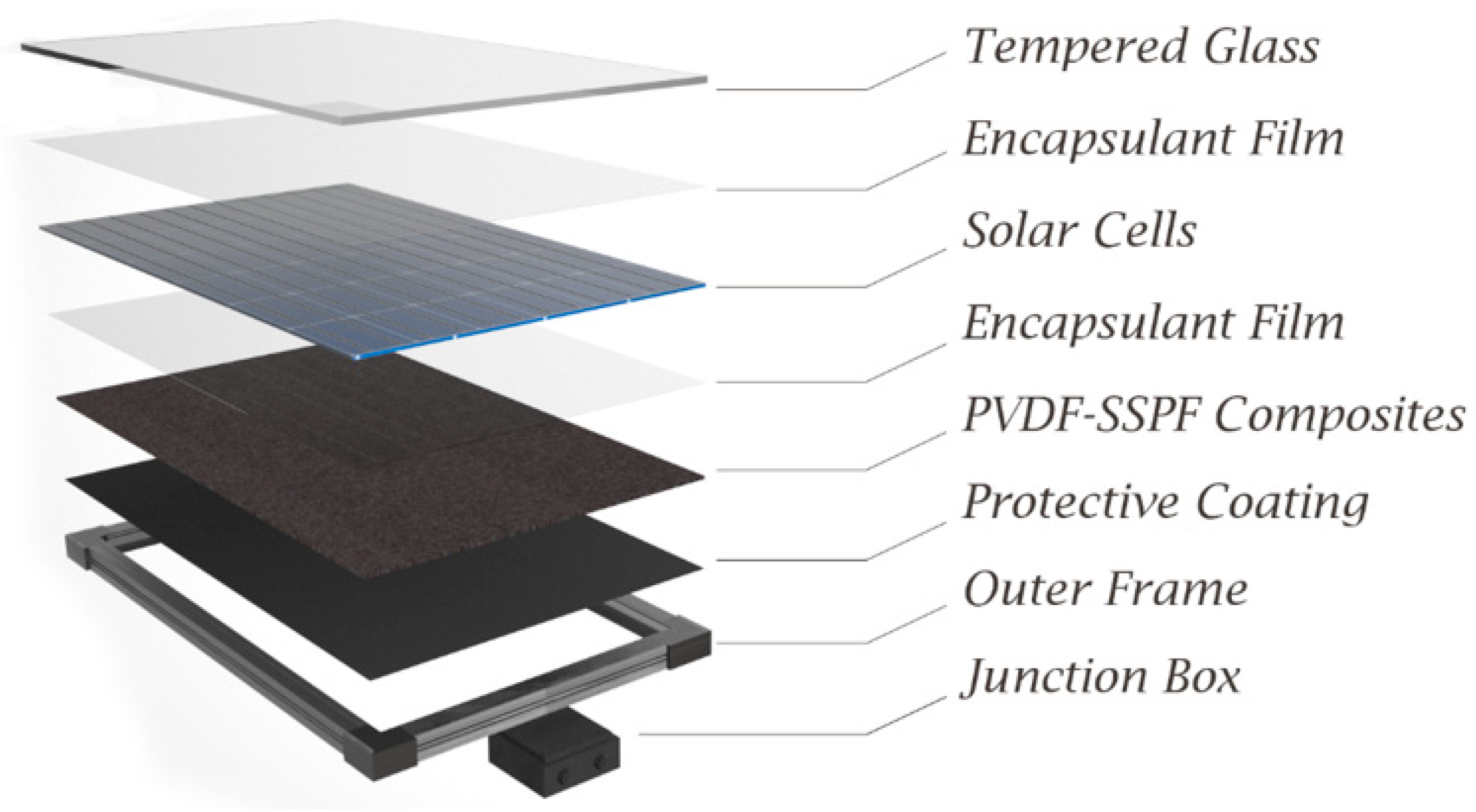

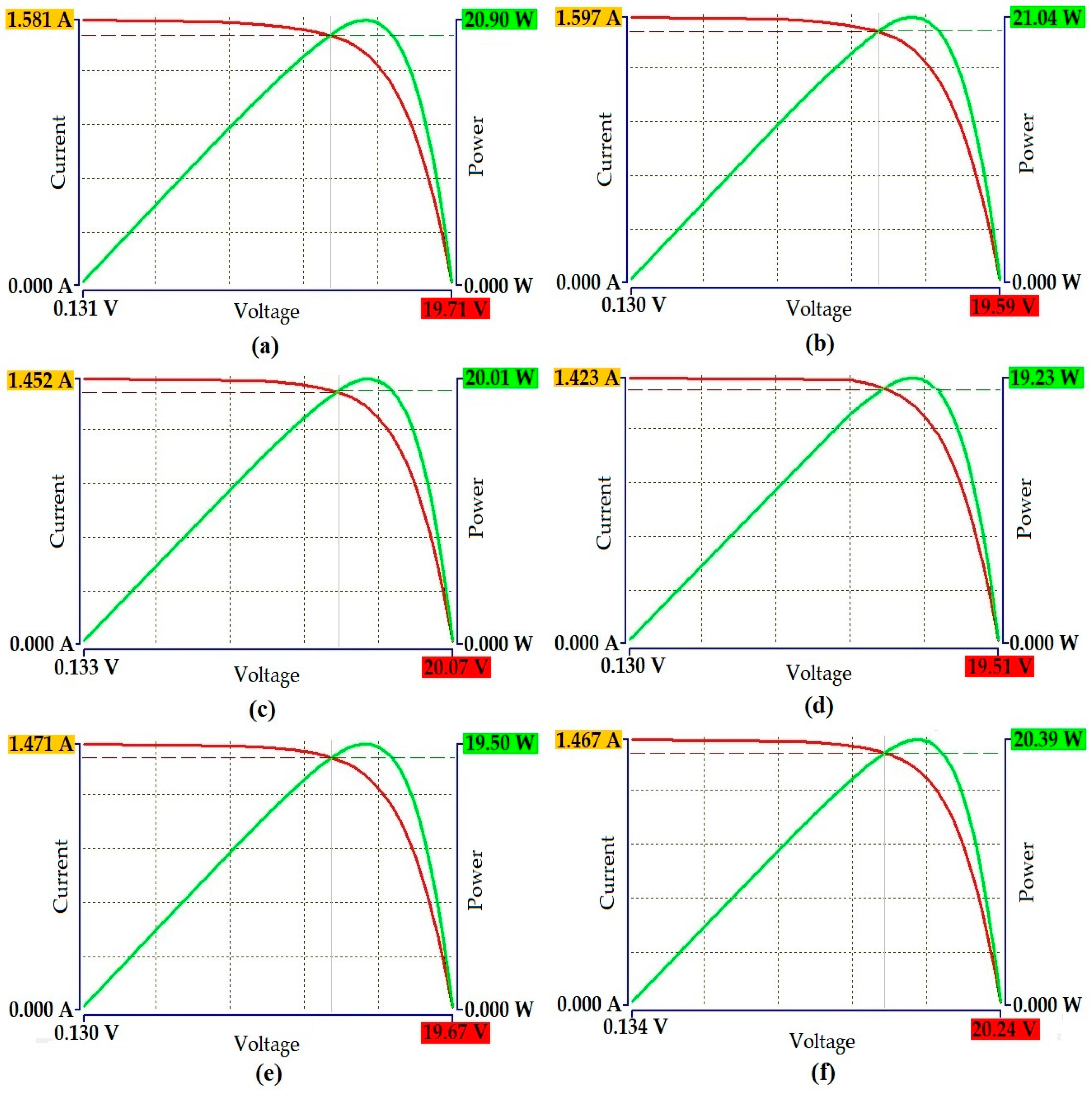
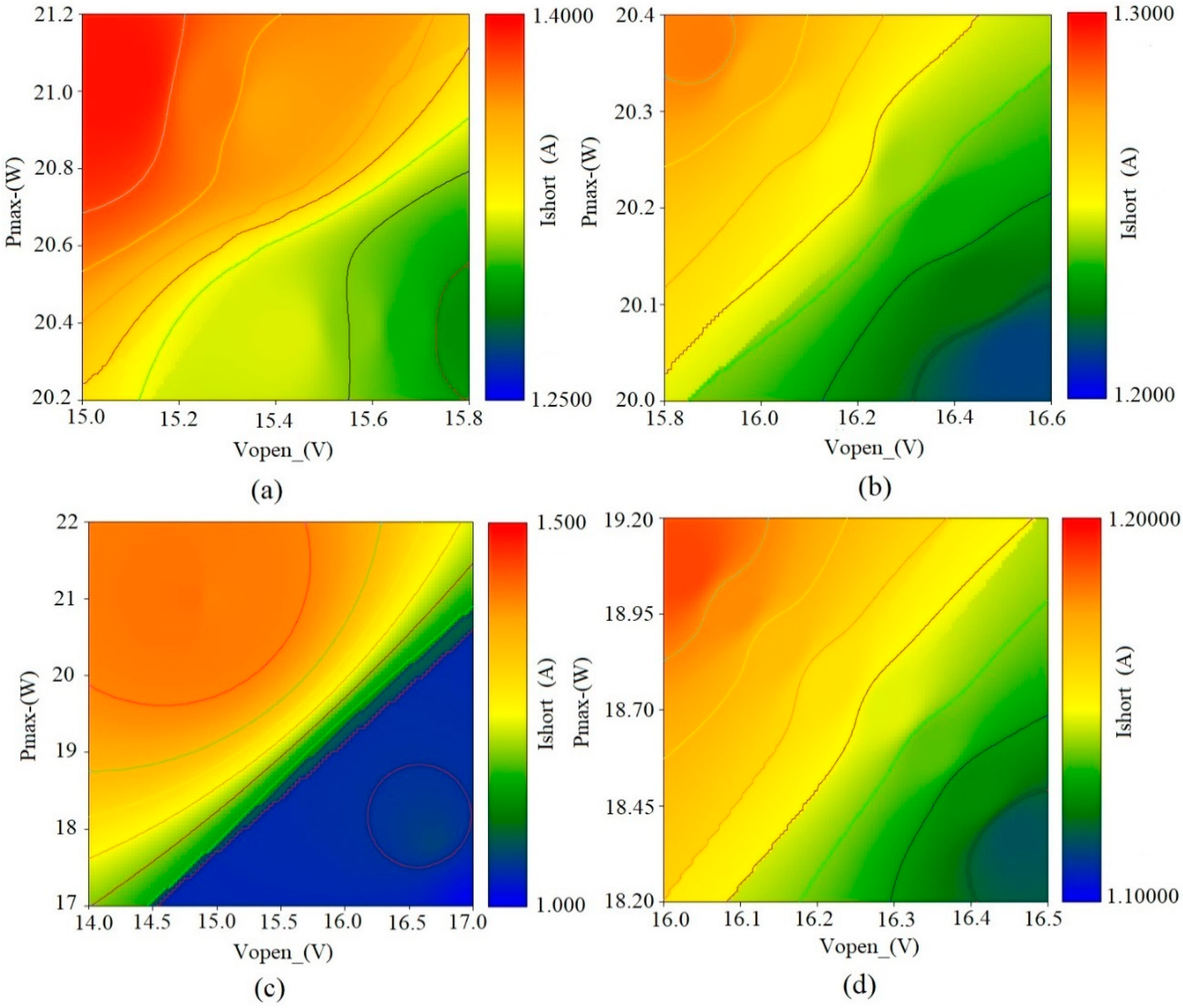


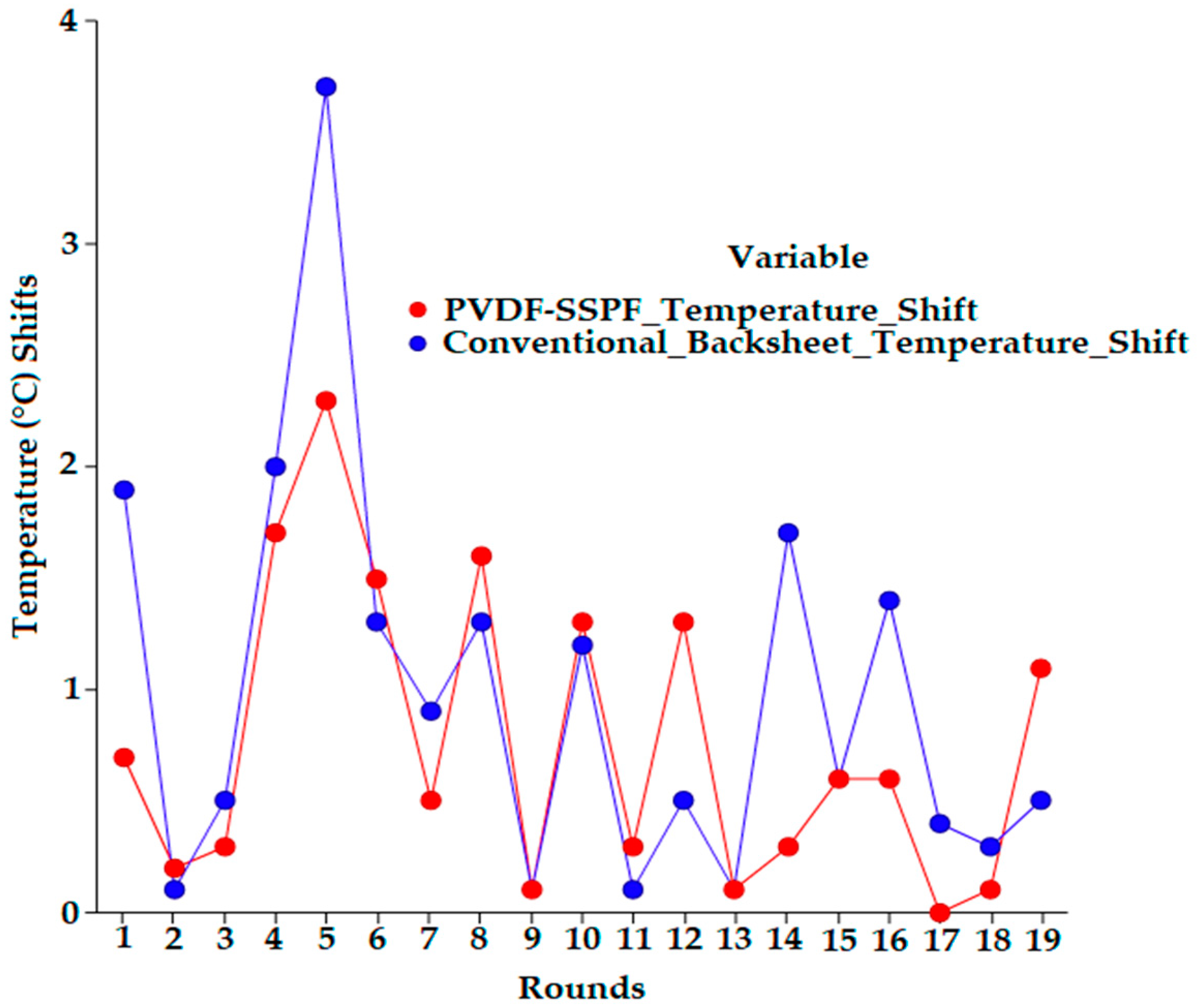
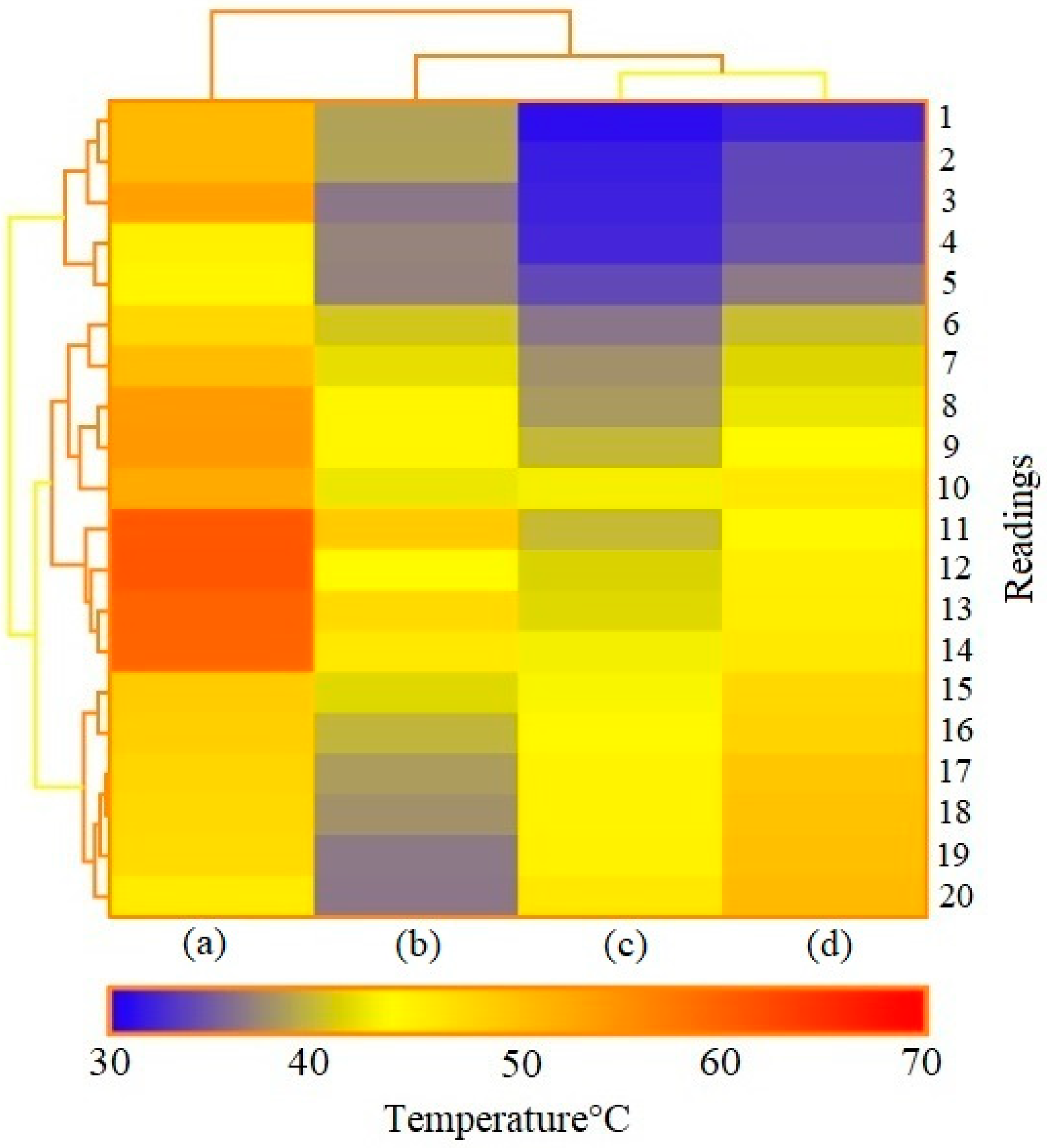
| Phase | Readings | Temperature (°C) | Vopen (V) | Pmax (W) | Vmaxp (V) | Ishort (A) |
|---|---|---|---|---|---|---|
| A1 | IV-a | 28–33 | 19.71 | 20.90 | 15.16 | 1.581 |
| IV-b | 28–33 | 19.59 | 21.04 | 15.08 | 1.597 | |
| A2 | IV-c | 28–33 | 20.07 | 20.01 | 15.42 | 1.452 |
| IV-d | 28–33 | 19.51 | 19.23 | 15.20 | 1.423 | |
| A3 | IV-e | 28–33 | 19.67 | 19.50 | 15.08 | 1.471 |
| IV-f | 28–33 | 20.24 | 20.39 | 15.56 | 1.467 |
| Type | Temperature °C | |||||||||
|---|---|---|---|---|---|---|---|---|---|---|
| PVDF-SSPF | 31.1 | 31.8 | 32 | 32.3 | 34 | 36.3 | 37.8 | 38.3 | 39.9 | 40 |
| Conventional | 32 | 33.9 | 34 | 34.5 | 36.5 | 40.2 | 41.5 | 42.4 | 43.7 | 43.8 |
| PVDF-SSPF | 41.3 | 41.6 | 42.9 | 43 | 43.3 | 43.9 | 44.5 | 44.5 | 44.6 | 45.7 |
| Conventional | 45 | 45.1 | 45.6 | 45.7 | 47.4 | 48 | 49.4 | 49.8 | 50.1 | 50.6 |
© 2019 by the authors. Licensee MDPI, Basel, Switzerland. This article is an open access article distributed under the terms and conditions of the Creative Commons Attribution (CC BY) license (http://creativecommons.org/licenses/by/4.0/).
Share and Cite
Alaaeddin, M.H.; Sapuan, S.M.; Zuhri, M.Y.M.; Zainudin, E.S.; M. AL-Oqla, F. Development of Photovoltaic Module with Fabricated and Evaluated Novel Backsheet-Based Biocomposite Materials. Materials 2019, 12, 3007. https://doi.org/10.3390/ma12183007
Alaaeddin MH, Sapuan SM, Zuhri MYM, Zainudin ES, M. AL-Oqla F. Development of Photovoltaic Module with Fabricated and Evaluated Novel Backsheet-Based Biocomposite Materials. Materials. 2019; 12(18):3007. https://doi.org/10.3390/ma12183007
Chicago/Turabian StyleAlaaeddin, M. H., S. M. Sapuan, M. Y. M. Zuhri, E. S. Zainudin, and Faris M. AL-Oqla. 2019. "Development of Photovoltaic Module with Fabricated and Evaluated Novel Backsheet-Based Biocomposite Materials" Materials 12, no. 18: 3007. https://doi.org/10.3390/ma12183007





